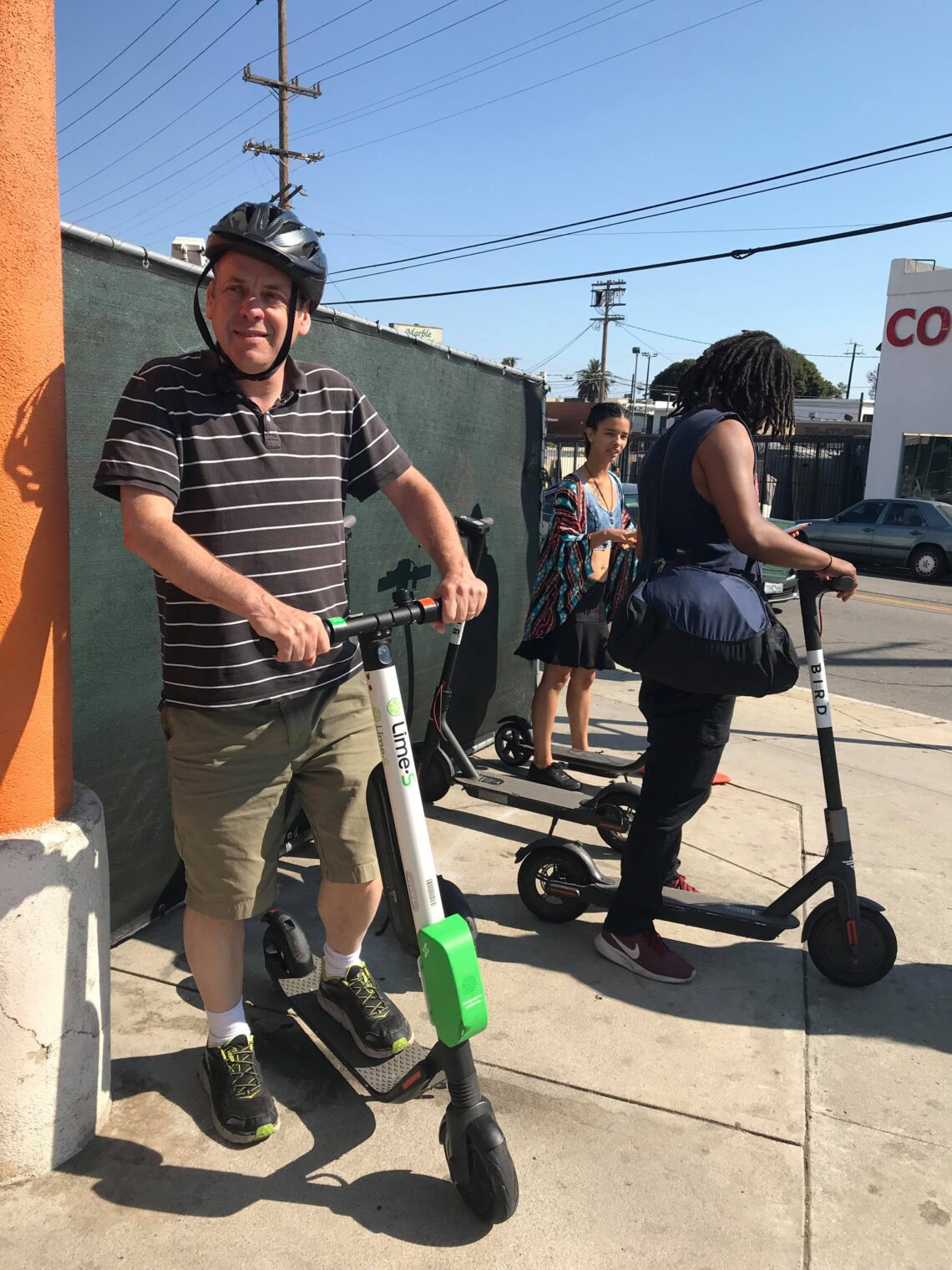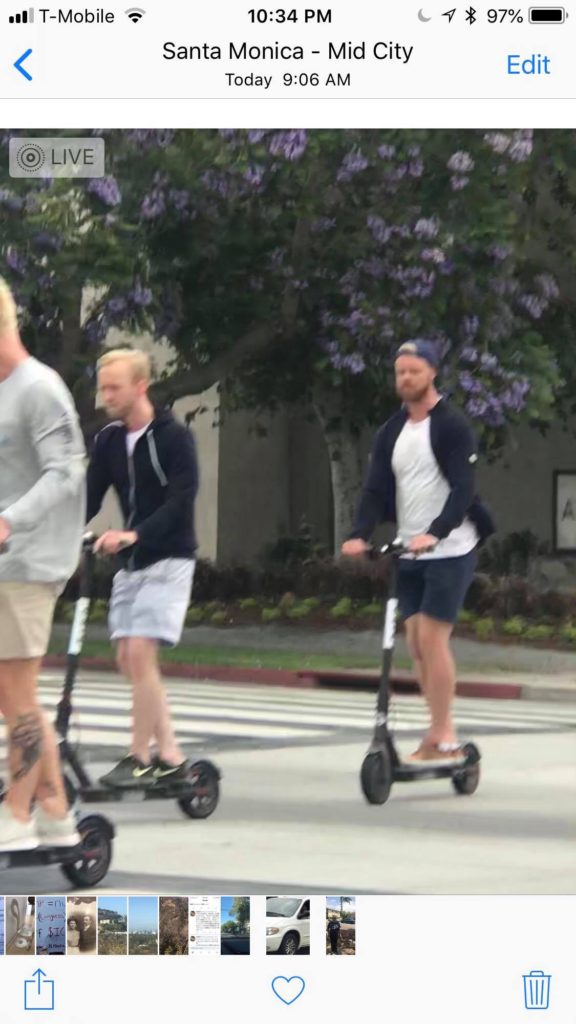Why did a Big VC Firm Give a Scooter Rental Company $300m?
2018-07-11
Visit Santa Monica, and You’ll See – Scooters are Everywhere!
Los Angeles is famous as the home of the USA car culture. But, today if you visit West Los Angeles or Santa Monica, you will see something very strange and new. On almost every street, you see cars sharing the road with people riding tiny electric scooters.
Scooters are also appearing on many other cities, college campuses, and others at a rapid rate.
 *People riding scooters in Santa Monica on a street where no one is driving cars.
*People riding scooters in Santa Monica on a street where no one is driving cars.
Massive Fundraising
New electric scooter companies in the USA are getting a crazy amount of money. Bird Scooters just raised $300m. Lime, which, was just given $70m in February of this year, and it was rumored to be raising $500m, with Google joining the investors. Lime has ended up to raise $335m led by GV(Google Ventures), and Uber also joined the round.
How it is possible that in the USA, land of the Automobile, VCs believe so much in the Scooter business that they will invest hundreds of millions of dollars? Because, there is a good chance that scooters will change …everything, disrupting some part of the transportation industry. Some notes:
-Electric Scooters are fast, cheap, convenient, and good for the environment. Finding a scooter is faster than waiting for a bus. But they are also faster and cheaper than an Uber. For example, in San Francisco, someone can go from the Caltrain station to the Financial district on a scooter in about 10 minutes, even if there is a lot of traffic, and pay about $3. An Uber would take 20 minutes, and cost double that.
-Disruption is already happening in the transportation industry. Note there are also with electric cars, self-driving cars, Tesla, car share, Uber/Lyft all challenging traditional car ownership and driving. Scooter can, therefore, ride the disruption wave.
–Fear Of Missing Out (FOMO). VCs who have missed investing in Uber/Lyft, Facebook, etc, see something that is potentially very, very big.
How Do the Scooters Work
The Lime App shows you a map. The scooters are placed all over the city, so the user can find them and start riding within a couple minute walk from just about anywhere. They are what is called “Dockless” meaning, they don’t have any central location where they are stored, they are just left on a sidewalk or street where another rider can pick them up.
Once the user finds the Scooter, they unlock it by scanning it with their phone, and off they go, immediately. (Compare to calling an Uber, waiting 5 minutes, sometimes you can’t find the driver…etc).
The scooters are easy to ride and go up to 15 miles per hour. In a busy city like Santa Monica or San Francisco, they go on the bike lane or sidewalk, often faster than a car in traffic. Once the rider gets to their destination, they just leave the scooter there. That’s it!
From a technology perspective, it is a perfect coming together of many newer technologies that could only happen now, including better batteries, apps, smartphone GPS, and more.

*Lime Scooter map in Santa Monica. You can see the scooters are everywhere!
Banned in San Francisco
The scooters sound great, but San Francisco just banned them! Why is that?
The stated reason for the ban was that the scooter companies had copied what Uber did earlier – they never asked the cities for permission. So, San Francisco has said no scooters allowed until each company applies and is granted a permit. Permits will only come when the scooter companies can demonstrate concern for safety procedures and also address concerns raised by residents.
Many complaints have come from people who find scooters dangerous for others (possibly hitting people), dangerous for riders (most do not wear a helmet), cluttering the sidewalks, and, it appears, are a symbol of young tech employees knows as “Tech Bros” taking over the city and being arrogant.

*Young people riding Bird Scooters. The riders get called “Tech Bros,” although they may or may not work in technology.
Implications of the Scooter Trend
Lime published data showing that 60% of trips on a Lime replaced a car trip. If scooters continue to grow rapidly in the USA, there are many implications, such as:
-Fewer people owning cars. There is already a trend of millennials delaying car ownership, and scooters make it easier not to have a car.
-Less parking needed
-Less traffic
-Less need for Uber or Lyft
-Fewer emissions, helping the planet.
What is Next?
Scooters will continue to expand rapidly in the USA – if for no other reason because the VCs are giving them the money to do it. One newly emerging risk is the Trump trade wars, with a proposed new 25% tariff on US scooter imports from China. However, even the tariff wouldn’t slow things down that much, since the VC money funds rapid, non-profitable expansion by definition.
Scooters should continue to do well and expand in downtown areas, college campuses and other more dense areas. There is a regulatory risk but, since USA cities each have their own laws, the risk is to expand in each city rather than across the country.
A big question is if they can penetrate other parts of the USA, with a less dense population. Other questions include their impact on transit. One could argue Scooters are so much easier and faster than taking a bus, so for short distances, Scooters may end up taking over those routes. Yet, for long distance buses and trains, scooters make transit better, solving the “last mile” problem. In Japan, there are large bicycle parking lots outside of many train stations; in the USA we don’t have those, and bicycle theft is often an issue, so scooters can really help transit utilization here.
One other implication is multimodal. Already, Volkswagen has announced a new car share program that will include scooter share. Uber and Lyft have both bought bike share companies, partly to compete with scooters. Therefore, there will be a future where people can find and ride transportation including a shared car, bike, scooter, bus and train, all accessible from a single app.
Written by Ron Drabkin, Venture Partner at DreamVision Inc. Serial Entrepreneur & Angel Investor based in Silicon Valley.